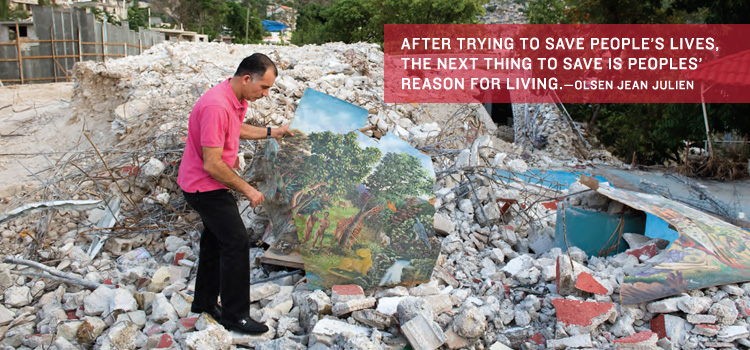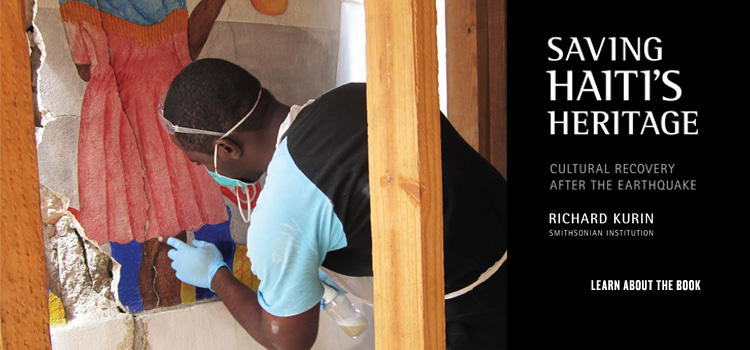The Haiti Cultural Recovery Project works to rescue, recover, safeguard and help restore Haitian artwork, artifacts, documents, media and architectural features damaged and endangered by the earthquake and its aftermath.
The project is organized by the Smithsonian Institution with the Government of Haiti, Ministry of Culture and Communication and the Presidential Commission for Reconstruction, in partnership with the U.S. President�s Committee on the Arts and the Humanities. The project is supported by the U.S. Department of State through US AID, the National Endowment for the Arts, National Endowment for the Humanities, Institute of Museum and Library Services and the Broadway League and Broadway community. Additional funding has been provided by Affirmation Arts Fund, Peggy Burnet, National Haitian Art Society, Macondo Gallery, Waterloo Center for the Arts, Friends of the Art Center, Jerome and Thao Dodson. Program partners include the U.S. Committee of the Blue Shield, the Foundation of the American Institute for Conservation, La Fondation Connaissance et Libert� (FOKAL), the International Centre for the Study of the Preservation and Restoration of Cultural Property (ICCROM), UNESCO and the William J. Clinton Presidential Library.
The project is managed by the Smithsonian Institution. The Steering Committee consists of the Institut de Sauvegarde du Patrimoine National (ISPAN), Mus�e du Panth�on National Ha�tien (MUPANAH), Biblioth�que Nationale (BN), Archives Nationales d'Ha�ti (ANH) and Bureau National d'Ethnologie (BNE).
Project Operations
The Cultural Recovery Center occupies a three-story building within a walled compound in the hills above Port-au-Prince. Formerly used by the U.N. Development Program, it was certified safe by U.S. Navy and Smithsonian engineers. It is managed by the Smithsonian and meets safety and security standards. Work at cultural sites is done with the permission of the owners. All cultural items remain the property of the owners, public or private. At cultural sites, including the stored rescued collections, center personnel conduct assessments of the condition and determine the status of cultural materials. All items are documented and registered and treatment is carried out by, or under the supervision of, trained professionals of the Smithsonian, the American Institute for Conservation, the U.S. Committee of the Blue Shield and/or other qualified cooperating organizations. The training program for Haitian cultural workers and students is organized by ICCROM.Haiti Cultural Recovery Project
The catastrophic earthquake that struck Haiti on January 12, 2010, killed more than 250,000 people, left over 1.5 million homeless and destroyed much of the nation’s infrastructure. It also devastated Haiti’s rich cultural heritage. Historic buildings, museums, libraries, archives, galleries, churches, theaters, artists' workshops and marketplaces were damaged and ruined. Thanks to many brave and concerned Haitians, some cultural collections were saved, but most are stored in poor conditions and many are still under the rubble. Haitians rightly value their cultural heritage as a source of identity and dignity. It is a legacy of freedom and creativity that gives the Haitian people the resilience to survive and the promise of a better life.Most of Haiti’s cultural heritage is now endangered. The Haitian government has joined with the Smithsonian and international organizations for the Cultural Recovery Project.
The Project aims to rescue, safeguard and preserve Haiti’s important collections of art, artifacts, museum objects, architectural features, documents, film, photographs and video and sound recordings. The Cultural Recovery Center in Bourdon is equipped with labs and experts to help stabilize and restore art, objects, paper and other media. Some experts will help pull cultural materials from the rubble; others will help train Haitians in conservation work. A committee of Haitian cultural leaders will help prioritize collections to be saved, with the permission of the owners or stewards of those materials.
Ancillary activities, including Smithsonian programs and exhibitions strive to preserve and safeguard Haiti’s living culture. The project has received ample media attention, including articles in the New York Times, Washington Post, and Wall Street Journal, coverage by CNN, and Haitian media.








